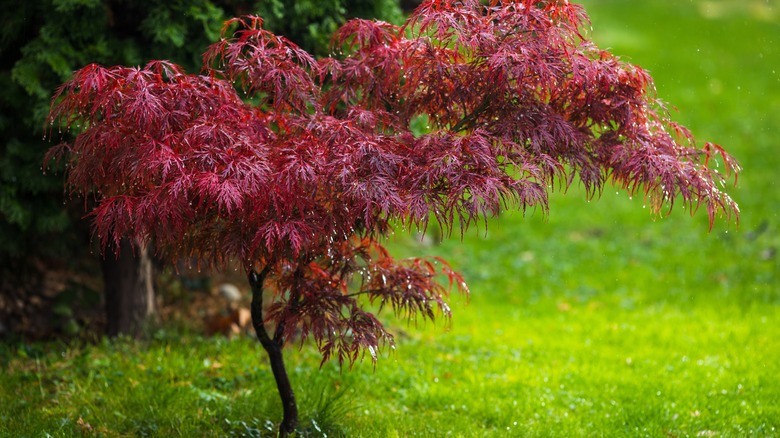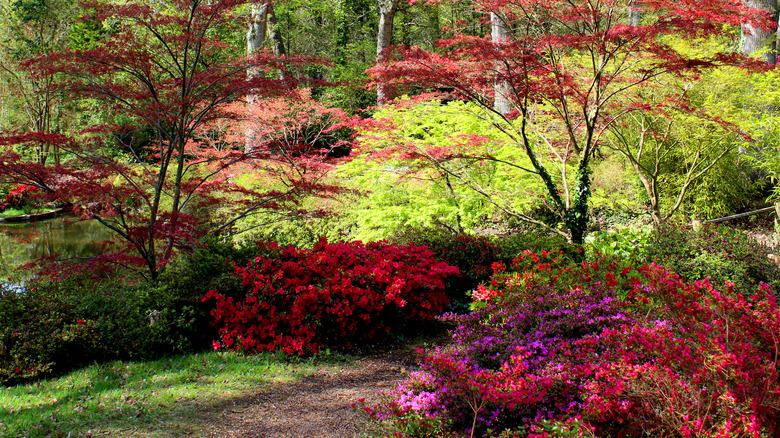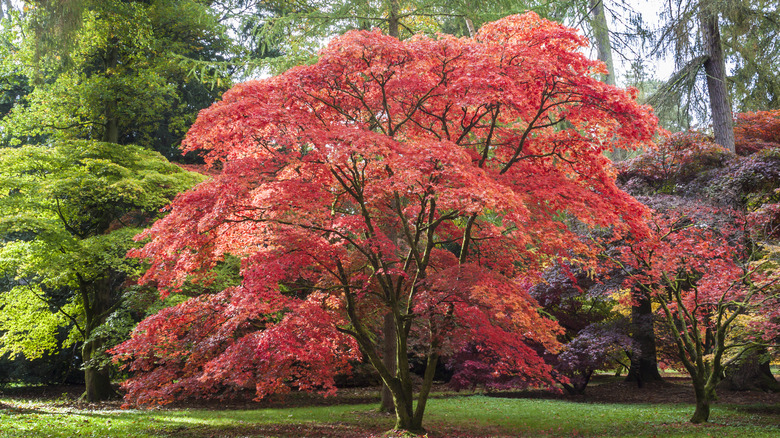The Best Place To Plant A Japanese Maple Tree, According To Our Professional Gardener
Japanese maple trees are beautiful deciduous trees that produce delicately shaped leaves, providing wonderful texture and color in the landscape. These trees are long-lived, on the shorter side, and somewhat slow-growing. They prefer dappled shade to full sun and do best in a partial shade area. The best location for a Japanese maple tree is one that will accommodate its mature size and provide the proper amount of partial sunlight exposure: beneath the shade canopies of larger trees is often a good choice.
If you're planting a Japanese maple tree, there are a number of considerations for choosing a variety that's right for you. This tree has a USDA hardiness zone range of 5 to 8, with a few cultivars that are cold hardy to Zone 4. The mature heights for most varieties range from 15 to 25 feet tall, but some are smaller at 4 to 5 feet tall. You will also want to consider the tree's overall shape (some are rounded like shrubs, some have a spreading shape, some have a "weeping" habit) and the colors of the foliage, which will likely change through the season. I've seen some Japanese maples that exhibit foliage in three or more distinct colors from spring through autumn. Once you've decided on the variety of Japanese maple tree you want, choosing a proper location is key. Consider the foliage colors and how they will complement other plants or trees. Also, sunlight exposure is crucial to the tree's well-being: too much shade might prevent your Japanese maple tree from achieving the peak color of its much-admired autumn foliage, but too much sun might dry out or burn the leaves.
Trees and shrubs that complement Japanese maples
Choose the location of your Japanese maple by looking at the other trees and plants in the vicinity. To allow for partial sunlight exposure, plant your Japanese maple beneath a shade tree with a spacious canopy, such as oak, sugar maple, silver maple, bronze maple, or beech), as opposed to ones with dense shade or year-round foliage (like evergreens). Avoid planting them near or beneath fast-growing trees such as river birch, red maple, or tulip poplar, which might overshade them too much.
Some trees offer vivid colors in autumn that can be wonderful complementary companions to your Japanese maple's fall foliage. Try colorful options like a purple smoke tree, flowering dogwoods, or beech trees that produce brilliant yellow and gold foliage. In addition to color, mull over the shape and texture of leaves. Japanese maple leaves can be angular (like 'Beni-Kawa'), rounded (like 'Full Moon'), or lacy in shape (like 'Crimson Queen'), depending on the variety. Also, consider the overall shape of your tree at maturity. A smaller, rounded, shrub-like weeping Japanese maple tree (like 'Red Dragon') can fit into a varied landscape with differently-shaped trees and shrubs. A taller spreading one (like 'Emperor') might look best with some flowering shrubs planted beneath it. Azaleas and rhododendrons work well as companion plantings, as both of these also enjoy dappled shade conditions and the slightly acidic soil preferred by Japanese maples. Also, their flowers appear just as Japanese maples begin to show their first spring leaves.
Long term considerations for your Japanese maple
Japanese maples can live up to 60 years or even longer, depending on the variety, but are often considered a slow-growing tree. For this reason, some gardeners may plant them in locations without fully considering their mature size and spread — but this is a mistake. Additionally, it's important to consider nearby trees and shrubs, which may have different rates of growth and spread. Some fast-growing trees, like weeping willows, cottonwoods, or some poplars, have weak wood and tend to have problems with breaking limbs and falling branches, which might damage your Japanese maple over time.
Think about the spread of your Japanese maple's canopy. This can sometimes be equal in width to the tree's mature height! You don't want to have to prune back your Japanese maple's beautiful branches to keep them from growing into another tree or structure, so check the mature size specifics for the variety you're planting and make sure it will have plenty of room to grow into its mature splendor. Since they grow slowly, a Japanese maple tree's roots may become exposed due to soil erosion. I have noted this with smaller weeping trees where it's not as easy to see beneath the tree, so be sure to check. Having ground cover plants beneath trees might also affect the health of tree roots over time, especially thickly growing ones, like lily of the valley or pachysandra, which are best to avoid growing beneath your Japanese maple. Add a layer of composted manure or other soil amendments to the soil around your Japanese maple every couple of years to keep the soil healthy.


